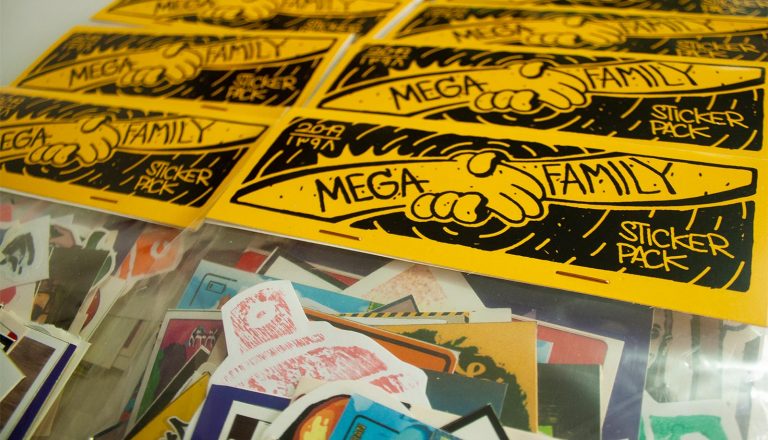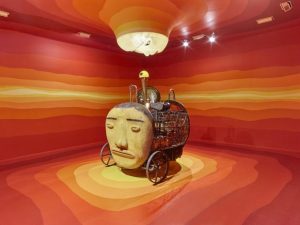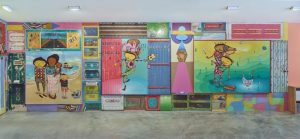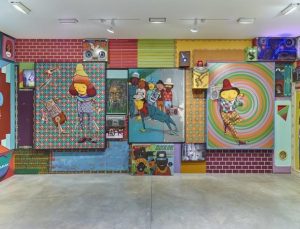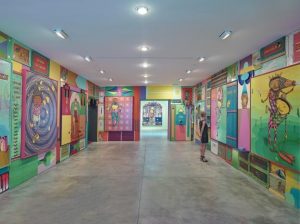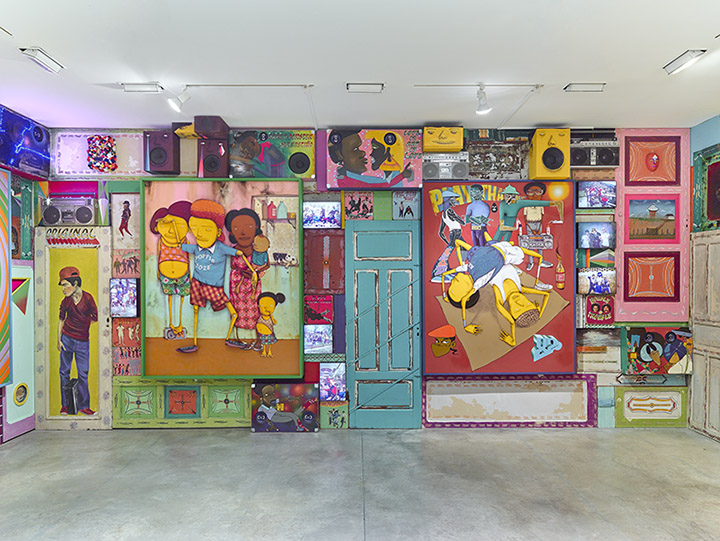
! Os Gemeos “Silence of the Music” Solo Show @ NYC’s Lehmann Maupin
Lehmann Maupin is pleased to announce Silence of the Music, the Brazilian artist duo OSGEMEOS’ first New York solo show with the gallery. Twin brothers Gustavo and Otavio Pandolfo will transform multiple rooms into an immersive installation that combines drawing, painting, collage, mixed media sculpture, and kinetic and audio elements. These newest works represent an evolution of the style OSGEMEOS has honed over decades, while also returning to their early experimentation with diverse mediums, including new oil paintings. This exhibition will offer a heightened multi-sensory experience that embraces the power of human imagination and the vast possibilities in visually interpreting the subconscious. The gallery will host an opening reception on Thursday, September 8, from 6-8PM.
OSGEMEOS broke onto the art scene in the late 1980s as graffiti writers in their São Paulo neighborhood of Cambuci, and are now internationally recognized for a figurative style that typically features their signature yellow characters, thin dark red outlining, and intricately patterned designs. Initially influenced by the graffiti movement coming out of New York, they were ultimately inspired by the ingenuity and resourcefulness evident in their working class neighborhood. They made their art accessible to the community as a way to contribute a sense of optimism in the midst of the economic disparity, violence, and drug use that proliferated. They believed that the popular Brazilian art movements of the time, which favored conceptual, minimalist, and concrete art, were limiting to a wider audience. Instead, they embraced work by self-taught artists like Arthur Bispo do Rosario, who created all of his work from a Rio de Janeiro mental institution during the 1930s. Following a 1993 visit with the prominent San Francisco-based artist Barry McGee, the twins developed a rigorous studio practice while continuing to make murals. This allowed them to extend their unique artistic vision beyond the streets to an international audience that includes galleries, museums, and private collections. OSGEMEOS’ practice continues to be marked by a commitment to the accessibility of art and to exposing the realities of the working class while also celebrating its resilience.
Silence of the Music extends OSGEMEOS’ approach to an exhibition as a total work of art, a concept exemplified in their Institute of Contemporary Art, Boston solo exhibition in 2012. Conceived as a site-specific installation, each room contains a unique grouping of paintings and objects that cover the wall, floor to ceiling. The exhibition pays tribute to music in particular. Included in their “B-Boy” room are boom box paintings—canvases with embedded speakers that play tracks linked to the imagery on the canvas—and interactive sculptures that play LP records. For OSGEMEOS, the era during the 1970s and 1980s was an influential time of discovery and sharing; the improvisational structure, descriptions of everyday life on the streets, and bravado in sharing these stories that this golden age of hip hop fostered is intrinsically linked to their practice.
Similar to the surrealist artists of the early 20th century, OSGEMEOS seek to defy conventions and push boundaries in art and society through the unbridled exploration of the subconscious and imagination. In direct contrast to the surrealist notion of a solitary dream space, however, the twins have described a shared intuition and subconscious experience that is translated visually through their collaborative process. They often allude to this notion of duality with their incorporation of the sun and moon, which is representative of masculine and feminine forces.
The room “Kiss” is painted in bright hues that exude a sunny splendor and is anchored by a mechanical sculpture, representative of the masculine, which plays compositions arranged by OSGEMEOS together with their brother. A sculpture affixed to the ceiling directly above it, depicting a female, moon-shaped face, seemingly kisses the floor sculpture to trigger the music played. This imagery and their installations are meant to conjure a lucid dream state and empower the audience to consider their own subconscious.
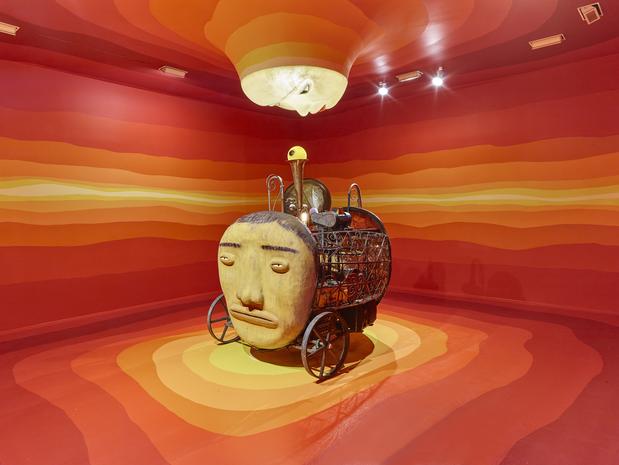
OSGEMEOS’ symbolism extends to their characters as well, whose indiscriminate yellow tone is meant to defy racial associations, an artistic decision meant to emphasize unity and the establishing role that diversity plays in their native Brazil and abroad. The twins often incorporate masks, instruments, and musicians in their work as a way to visualize the folk customs, festivals, and crafts that represent the myriad of cultural influences that make up the social and cultural landscape. Silence of the Music combines folk art, pop culture, and urban detritus in order to offer an expansive impression of the artists’ unique artistic perspective and creative process.
OSGEMEOS is a collaborative art duo comprised of twin brothers Gustavo and Otavio Pandolfo (b. 1974, São Paulo, Brazil; live and work in São Paulo). Solo exhibitions of their work have been organized by the Institute of Contemporary Art, Boston (2012); Berardo Collection Museum, Lisbon (2010); and Museum Het Domein, Sittard, Netherlands (2007), among others. Select group exhibitions featuring their work include Art in the Streets, Museum of Contemporary Art, Los Angeles (2011); Viva la Revolucion: A Dialogue with the Urban Landscape, Museum of Contemporary Art, San Diego, CA (2010); and When Lives Become Form: Creative Power from Brazil, Museum of Contemporary Art, Tokyo (2008). Their work is in numerous international public collections, including The Frank-Suss Collection, London; Museu de Arte Moderna, São Paulo; Museu de Arte Brasileira, São Paulo; and the Museum of Contemporary Art, Tokyo. In 2014, OSGEMEOS was included in the Vancouver Biennial. Major public commissions include HangarBicocca, Milan (2016); Parallel Connection, Times Square Arts: Midnight Moment, New York (2015); Wynwood Walls, Miami (2009); Tate Modern, London (2008); and Creative Time, New York (2005).
"سکوتِ موسیقی" نمایشگاه انفرادی OSGEMEOS در Lehmann Maupin نیویورک
لهمن ماوپین (Lehmann Maupin) با افتخار برگزاری نمایشگاه “سکوتِ موسیقی” را به اطلاع میرساند، اولین نمایشگاه انفرادی OSGEMEOS در نیویورک. برادران دوقلو با نام های Gustavo و Otavio Pandolfo اتاق های گوناگون گالری را به تأسیسات بزرگی تبدیل خواهند کرد که ترکیبی ست از طراحی ها، تابلوهای نقاشی، کلاژ روی دیوار، مجسمه سازی با نقاشی ترکیبی و عناصر صوتی متحرک.
کارهای جدید آنها نمایشگر سیر تکاملی سبک شان و مقدار پیشرفت OSGEMEOS در دهه های اخیر است. آنها در لا به لای این آثار، به نخستین تجربیات خود مانند نقاشی با رنگ روغن نیز، گریزی زده اند. این نمایشگاه یک تجربه ی چندحسی را عرضه خواهد کرد که قدرت تخیل انسان را به چالش میکشد و امکانی فراهم میکند تا ناخودآگاه بصورت دیداری تفسیر شود.
گالری در روز پنج شنبه، 8 سپتامبر، و از ساعت 6 صبح تا 8 عصر پذیرای بازدید کنندگان خواهد بود.
اوسگمئوس (OSGEMEOS) در اواخر سال 1980 بعنوان هنرمندان خیابانی در مجاورت شهر سائوپائولو (بزرگترین شهر برزیل)، وارد عرصه ی هنر شدند. آنها به علت سبک تمثیلی شان که بطور رمزی و تشبیهی دارای شخصیت هایی زرد رنگ، خطوط باریک قرمز پررنگ، و طراحی های پر نقش و نگار و پیچیده است، به سرعت در سطح بین المللی شناخته شدند. این دو برادر در ابتدا با جنبش گرافیتی موجود در نیویورک ترغیب شده و سپس از نبوغ و ابتکار طبقه ی کارگری که در همسایگی شان بود، برای کار الهام گرفتند.
آنها هنر خود را در دسترس عوام قرار دادند تا در میان اختلافات اقتصادی، خشونت موجود در جامعه، و استفاده ی مواد مخدر که افزایش بسیاری یافته بود، موجب ایجاد یک حس خوش بینی شوند. آن دو اعتقاد داشتند که جنبش های هنری حال حاضر در برزیل، که از هنرهای مفهومی، مینی مال و هنر ترکیب شعر و تصویر حمایت میکنند، درحال محدود شدن به مخاطبان بیشتری هستند؛ بنابراین کار خود را در کنار هنرمندان خودساخته ای مانند Arthur Bispo do Posario ، که تمام کارهایش را از مؤسسه ی فکری شهر ریو دوژانیرو برزیل خلق کرد، انجام دادند. این دوقلوها در پی دیداری که در سال 1993 با Barry McGee ، هنرمند برجسته ی مقیم سان فرانسیسکو داشتند، همزمان با نقاشی های دیواری، تمرین سختی را در استودیوی خود پیش گرفتند. این کار به آنها اجازه داد تا دید هنرمندانه و منحصر به فرد خود را به جایی فراتر از خیابان ها بسط دهند، مکان هایی شامل گالری ها، موزه های نقاشی و گردهم آیی های خصوصی. تمرین های OSGEMEOS تا جایی ادامه یافت که الزام در دسترس بودن هنر و در معرض نمایش گذاشتن واقعیت های موجود در طبقه ی کارگر را نشان میداد، درعین اینکه از بهبود وقایع نیز تجلیل میکرد.
“سکوت موسیقی” OSGEMEOS را به نمایشگاهی که بطور رسمی یک کار هنری تلقی میشد رساند، مفهومی که در مؤسسه ی هنر معاصر آنها با نمونه نشان داده شد، نمایشگاه انفرادی بوستون، در سال 2012.
این نمایشگاه به گونه ای تهیه شده بود که فضای آن همانند تأسیسات یک مکان ویژه بود، بطوریکه هر اتاق شامل گروه منحصر به فردی از نقاشی ها و اشیایی بود که دیوارها، کف اتاق و سقف را میپوشاندند.
این نمایشگاه احترام بخصوصی نیز برای موسیقی قائل شده بود. بعنوان مثال داخل اتاق های B-Boy روی بوم ها نقاشی هایی از ضبط های بوم باکس قرار داشت که بلندگوهایی در محل باندهایشان جاسازی شده بود، و به تصاویر روی بوم پیوند داده میشد؛ همچنین مجسمه های تأثیرگذاری که صفحه های 33 دوری روی گرامافون پخش میکردند.
دهه های هفتاد و هشتاد برای OSGEMEOS دوره های بسیار پر اهمیتی بودند، دوره هایی که صرف کشف و اشتراک، پی ریزی های مبتکرانه، و توصیف زندگی روزانه در خیابان ها شدند، و پهلوان پنبه هایی که این دوره از هیپ هاپ آنها را پرورش داد، بطور درونی ای ممارست آنها در کارشان را افزایش دادند.
هماهنند هنرمند سورئالیست ابتدای قرن 20 ام، OSGEMEOS در جست و جوی آنند تا به واسطه ی اکتشافات بی مهاری که از ناخودآگاه و تخیلات داشته اند، عرف ها و مرزهای موجود در هنر و جامعه را به مبارزه بطلبند.
با وجود تقابل مستقیم آثارشان با اندیشه ی سورئالیستی (سبک نگارش خیالی و فراواقعیت گرایی) از یک فضای رویایی پرت، این دوقلوها نوعی درک مستقیم و تجربه ی ناخودآگاه را توصیف کرده اند که بطور دیداری در این نمایشگاه دونفره تفسیر شده و قابل فهم است. آنها اغلب با تلفیق خورشید و ماه، که نشانگر قوای مردانه و زنانه است، به نظریه ی همزاد بودن نیز اشاره میکنند.
اتاق “بوسه” یکی از اتاق های این نمایشگاه است که با رنگ های روشن نقاشی شده و نشان دهنده ی یک شکوه روشن است. این رنگ ها توسط یک مجسمه ی ماشینی که نشانگر مردانگی ست، روی زمین محکم شده اند، که قطعه های هنری مرتب شده توسط OSGEMEOS و برادرشان را پخش میکند. یک مجسمه ی دیگر دقیقا در امتداد بالای آن به سقف چسبانده شده که چهره ی یک زن را بصورت ماه نشان میدهد؛ این زن به زیبایی مجسمه ی روی زمین را می بوسد تا موسیقی را راه بیندازد.

تصویرسازی و تأسیسات آنها نوعی جادوگری با حالت خیالی و درخشان است و این قدرت را به مخاطب میدهد تا ناخودآگاه خود را بسنجد.
نمادگرایی OSGEMEOS در شخصیت های آنها نیز دیده میشود، تن زرد رنگی که در شخصیت های آنها بکار رفته است، تماماً به معنای مبارزه با تجمع های نژادی ست، یک تصمیم هنری که برای تأکید کردن روی اتحاد و اثبات کردن نقشی که این گوناگونی رنگ ها بر انسان ها میگذارد، گرفته شده است.
این دوقلوها اغلب از نقاب ها، ابزارآلات و موسیقی های مختلف در کارهایشان استفاده میکنند. آنها معتقدند که این کارها، راهی برای به تصویر کشیدن سنت های محلی، جشن ها و هنرهایی ست که نشان دهنده ی هزاران توانایی فرهنگی هستند، و چشم انداز اجتماعی و فرهنگی را زیباتر میکنند.
“سکوت موسیقی” به جای اینکه یک عقیده ی گسترش پذیر از هنرمندانی که درک هنری و خلاقیت منحصر بفردی دارند عرضه کند، هنر محلی، فرهنگ پاپ و ریزه های شهری را با یکدیگر ترکیب کرده و ارائه میدهد.





